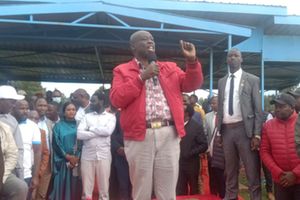Village in Siaya where gold rush fever has burned farm work

Residents crushing stones at a mining site in Kakamega.
In Uradi Village, Siaya County, agriculture, the backbone of Kenya’s economy, has been tossed to the back burner, and locals taken a risky path gambling into gold mining.
Farms known to be planted with drought-resistant and indigenous crops have been left fallow in the temporary switch to the gold rush that has benefited some and impoverished others depending on who you ask.
Even bodaboda operations, which have driven the area’s economy, have taken a break for now and passengers struggle to get riders who now must be booked in advance.
Renewed search for quick wealth through gold has disrupted the landscape, which is now dotted with dangerous open pits.
In a pandemic-stricken economy, hopes presented by the possibility of striking it rich one day have driven even more players from all ages and gender into the prospection of the precious metal.
“I lost my only source of income when schools were shut due to Covid-19. For months, life became tough without even the meagre salary I used to get as a BoM teacher,” Mr Samson Rwega, a 29-year-old teacher at a local primary school said. “I had to look for an alternative source of income to support my family. Gold mining became my next occupation,” he added.
In the dry January sun, the fine mist of dust from the crushers and mining pits covers the air, clouding the nose and eyes. Loud sounds from diesel-powered grinders have replaced those of motorcycles that have since gone silent as a new economy emerged.
Child labour
In the villages, child labour has become normal and tales of extortion are not rare in the fairy tales of becoming millionaires overnight from gold harvests.
Farmers have leased their lands, including ancestral homes to miners who, after excavating the precious commodity, exit the land leaving it unproductive and unsustainable. Abandoned pits have turned to death traps, detrimental to both residents and domestic animals.
Besides these harrowing concerns, residents here continue to nurse hopes that gold re-discovery will help them move out poverty.
For many, particularly youth, it is a get-rich-quick scheme. “We’ve been sitting on our fortune, literally. It is our turn to reap big from this discovery,” says John Olima, 27, one of the miners. The gold boom saw him park his motorbike and venture into something he had no experience about.
He does not intend to return to bodaboda riding anytime soon unless the gold boom subsides.
“Most businesses were already crippled due to lockdown. Why would I then stick to bodaboda, yet drilling gold can earn me more?” he asked.
But what stands out is how every mining site it semi-autonomous kind of management complete with a chain of power. It oversees daily operations and determines who works when, where, and what time. The chain flows from high-ranking officials, commonly known as wakubwa (bosses), to proxies who wield power to hire and fire manual labourers.
Bosses made up of unlicensed ‘gold experts,’ acquire and explore the land to establish gold availability. Residents, who will then serve as casual labourers, must register with a non-refundable fee of Sh2,000 and a weekly subscription of Sh200, which is given to the landowner. A single mining site, made up of about four pits, can accommodate up to 250 workers.
It’s a full-time job and from 7 am to 5 pm, miners drill down the earth in search of the precious commodity. Some go for night shifts as the curfew restrictions are forgotten in the rush that has attracted teenagers and women, some in their late 60s.
Gold miners
“Age does not matter here. Provided you are physically fit and can offer manual labour, either by extracting ore or working in the mines, you are considered an asset,” explains 45-year-old resident Martin Orwa (not his real name). He sought anonymity for fear of being branded a community mole.
Inexperienced gold miners such as John descend into the underground shafts, approximately 1,000 feet deep, equipped with a torch and shovel to extract gold-bearing ores. They are the so-called ‘RIP men’ because their survival is not guaranteed in case of an accident.
The underground ceiling and walls look saggy. The air is in short supply and the extreme underground temperatures are enough to trigger heat fatigue. Nevertheless, they remain undeterred, and as their nicknames suggest, they have already chosen death over poverty.
“Collapsing of walls and suffocation is a near norm in every mining shaft, ”says John while displaying a sarcastic smile. “If you die, that’s it. The body will be retrieved, but work must continue as usual. However, we are lucky that such incidents haven’t been experienced here since the discovery,” he adds.
As ‘RIP men’ labour in the oxygen-deficient pits, their female compatriots, mostly middle-aged women, await atop to pull the heavy buckets of ore onto the surface.
Food insecure
In Siaya County, gold businesses have been reported in neighbouring villages such as Ojalo, Barding, Onyatta, Asembo, Nyang’oma, among others. Despite the boon associated with gold mining, most residents here, about 70 per cent, still live below the poverty line. A 2016 report by World Food Programme (WFP) Kenya classified Siaya County as among the ‘most food insecure counties.’
According to environmentalist Wiliam Odeyo, artisanal gold mining is a seasonal venture with undefined economic viability. He says that “the business can go for months with a good return but disappear for years or decades.”
He, therefore, advises mining families “not to abandon agriculture as their fortunes can be short-lived.” Stunt crop growth, neurological orders, and pregnancy complications have all been linked to mercury poisoning, which is the main ingredient for extracting gold.




